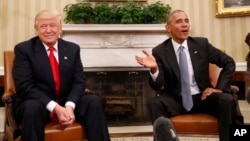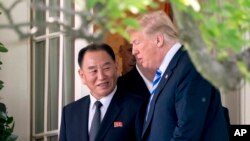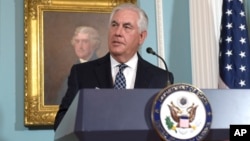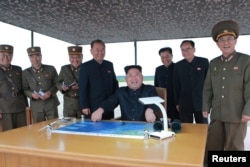Editor’s note: Dong Hyuk Lee is the Korean Service chief for Voice of America.
During a meeting regarding the transition, former President Barack Obama presented President-elect Donald Trump with two options for dealing with North Korea, said Jon Wolfsthal, a close Obama aide who served as senior director at the National Security Council for arms control and nonproliferation during the Obama administration.
The two options: Seek a freeze on North Korea’s nuclear and missile programs through direct engagement, or increase pressure on North Korea through China.
Obama advised Trump to pursue the pressure option, according to Wolfsthal. He specifically advised Trump to push for greater Chinese support to rein in the North’s nuclear development, he added.
“Making it clear to China that their continued protection of North Korea was beginning to undermine American security interests and that we would increasingly have to take steps to protect our interests in a way that might undermine China’s own security was a strategy that we believed was going to bear fruit,” Wolfsthal said during an interview with VOA Korean in February 2017, shortly after his departure from the Obama administration.
Pressure and engagement
Despite his repeated criticism of Obama for failing to stop North Korea’s nuclear development, Trump took Obama’s advice and employed it in his strategy. Pressuring China is a key element of Trump’s strategy on North Korea.
What makes Trump’s strategy different from Obama’s is it eventually pursues dialogue with North Korea.
Unlike Obama, who showed little interest in talks with North Korea, Trump is pursuing a dual strategy of pressure and engagement. He is using pressure and engagement in sequence: put pressure first and try engagement.
The purpose of Trump’s “maximum pressure campaign” is to press North Korea to return to dialogue and produce desirable outcomes from talks.
Trump’s strategy is a clear departure from the Obama administration’s, but it’s not unprecedented. A similar strategy was tried by William Perry, who served as secretary of defense from 1994-1997 under former President Bill Clinton. Perry advocated the so-called “coercive diplomacy,” that is, diplomacy backed up with a credible military threat.
US promises, silence on human rights
Trump sent a clear message to Pyongyang that his strategy is different from that of the previous administration: seeking dialogue while keeping sanctions in place.
In a bid to bring North Korea to the table and allay the North’s security concerns, the Trump administration laid out four actions the U.S. would not take against North Korea.
In August 2017, as tensions were rising rapidly after North Korea’s second intercontinental ballistic missile (ICBM) test, then-Secretary of State Rex Tillerson assured North Korea that the U.S. “will not seek a regime change, a collapse of the regime, an accelerated reunification of the peninsula, or an excuse to send military north of the 38th parallel.”
No previous U.S. administration had ever made such promises to North Korea in this way.
Trump has also been relatively subdued in his criticism of North Korea’s human rights violations compared with previous administrations, a stance that has drawn criticism from some members of Congress and human rights groups. Trump’s supporters, however, say his efforts to engage North Korea would not be productive if the administration raised the human rights issue strongly.
Top-down approach
Trump may soon to be the first sitting U.S. president to meet with a North Korean leader, with the upcoming summit in Singapore. His top-down approach has had its ups and downs, however.
Supporters say Trump has made far more progress in diplomacy with North Korea than any of his predecessors. The dramatic shift from a possible military confrontation to a flurry of high-level diplomacy in less than six months was only possible because of Trump’s full support, they say.
Supporters argue Trump’s commitment to dialogue contributed to the North Korean regime’s decision to return to talks, saying Pyongyang has been seeking a summit with a U.S. president for many years.
Critics argue Trump should not start the discussions, but that his involvement should be the carrot at the end of the process.
They also argue allowing a North Korean leader to have a face-to-face meeting with a sitting U.S. president alone is a huge concession to North Korea. Such a meeting gives legitimacy to the North Korean regime, which it badly needs, without offering the U.S. anything in return.
Some critics also suggest the summit helps Kim shift his image from that of a “brutal dictator” who executed his uncle and ordered the assassination of his half brother to a “skillful leader.”
Fate of dual strategy
The Trump administration has said it will keep sanctions in place against Pyongyang until a complete denuclearization of North Korea is achieved. It believes maintaining sanctions will give the U.S. the upper hand in negotiations with North Korea.
It has also vowed to increase sanctions and international pressure against North Korea if talks fail.
Critics warn, however, that Trump’s pressure campaign will lose momentum once talks are under way.
Trump’s critics say the consequences of failed talks are great, and that it would be difficult for the administration to revive diplomatic efforts for sanctions if talks collapse at the summit.
They caution it is unrealistic to unilaterally demand North Korea abandon its nuclear weapons, saying North Korea is likely to demand corresponding action from the United States.















